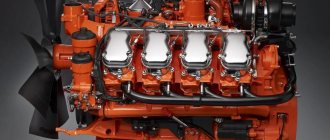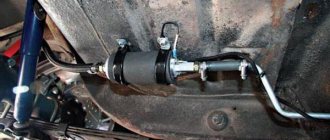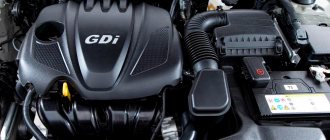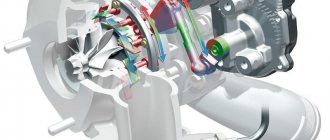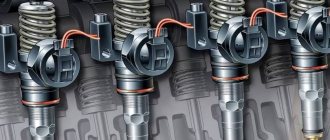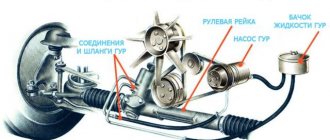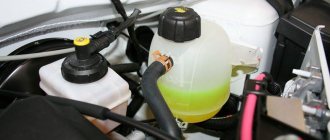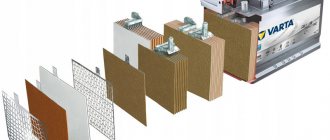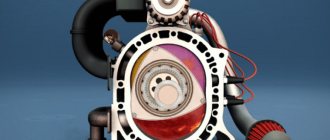The working cycle of an internal combustion engine is a periodically repeating series of sequential processes occurring in each working cylinder. The main task of the work process is to convert thermal energy from the combustion of the working fluid into mechanical work, in particular into the rotational movement of the crankshaft. Car engines most often operate on a four-stroke cycle, which is completed in two revolutions of the crankshaft or four strokes of the piston and consists of intake, compression, expansion and exhaust strokes.
In a carburetor four-stroke engine, the operating cycle occurs as follows.
The first stroke is intake.
The structure of a modern engine
|
The piston moves from TDC to BDC, and purified air enters the cylinder through the open intake valve (due to the vacuum created by the piston). The air is mixed with a small amount of exhaust gases remaining from the previous cycle, the temperature rises and at the end of the intake stroke reaches 300-320 K, and the pressure 0.08-0.09 MPa. The cylinder filling coefficient is 0.9 or higher, i.e. more than that of a carburetor engine.
What are dead spots and engine cycles?
The number of stages included in one working cycle of an internal combustion engine (ICE) is usually calculated based on the number of piston strokes in the cylinder. These stages are called engine strokes. The stroke of the piston is directly determined by its movement from one extreme point to another. They are called dead, because if the piston stops at such a point, it will not be able to start moving without external influence. In simple words, dead points are positions at which the movement in the current direction of the piston stops and it begins to reverse.
Dead spots and piston stroke of internal combustion engines
There are two dead spots:
- Lower (BDC) – the position at which the distance between the piston and the axis of rotation of the crankshaft is minimal.
- Top (TDC) - the position at which the cylinder is at the maximum distance from the axis of rotation of the engine crankshaft.
In English-language documentation, TDC is designated as TDC (Top Dead Center), and BDC is designated BDC (Bottom Dead Center).
There are engines whose operating cycle can consist of two or four strokes. Based on this, they are divided into two-stroke and four-stroke engines.
The third stroke is the working stroke.
At the end of the compression stroke (20-30 degrees of rotation angle of the crankshaft before the piston reaches TDC), a portion of fuel is injected in a finely atomized form through a nozzle into the cylinder under high pressure (15-20 MPa) using a pump. Fuel evaporates when it comes into contact with heated air, its vapors mix with the heated air and ignite. When fuel burns, due to the supply of a large amount of heat, the depletion and temperature of the resulting gases sharply increase. At the beginning of the expansion stroke, the gas pressure is 7-8 MPa. and the temperature is 2100-2300 K. Under the influence of pressure, the piston moves from TDC to BDC, performing useful work. The volume of the cylinder increases, the pressure and temperature of the gases decrease and when the piston approaches BDC they are 0.2-0.4 MPa.
Rocket engine
The rocket engine is the simplest of its family, so let's start with that.
In order to function in outer space, rocket engines require a supply of oxygen, as well as fuel, for their operation. The oxygen-fuel mixture is injected into the combustion chamber where it burns continuously. Gas under high pressure exits through the nozzles, causing thrust in the opposite direction.
To try this principle yourself, blow up a toy balloon and release it from your hands - a rocket engine works much the same way 
The fourth measure is release.
The piston moves from BDC to TDC. Through the open exhaust valve, the exhaust gases are pushed out through the exhaust pipe into the environment. At the end of the exhaust stroke, the gas pressure is 0.11 -0.12 MPa, the temperature is 850-1200. After this, the diesel operating cycle is repeated. In two-stroke engines, the time allotted for the working cycle is used more fully, since the exhaust and intake processes are combined in time with the compression and power stroke processes. The operating cycle occurs over 360 degrees (one revolution of the crankshaft).
When the piston moves from TDC to BDC, expansion and exhaust processes occur simultaneously with purging of the cylinder, and when the piston moves back from BDC to BDC, intake and compression occur. Changes in cycle parameters (pressure and temperature) correspond to changes in four-stroke engine parameters. A comparison of the operating cycles of four- and two-stroke engines shows that with the same cylinder dimensions and crankshaft rotation speed, the power of two-stroke engines is 1.5–1.7 times higher. It is simpler in design and more compact. The disadvantages of a two-stroke engine include the limited gas exchange time, which impairs the cleaning of the cylinder from exhaust gases, increases the loss of part of the fresh charge, and reduces efficiency.
Diesel engine operation, more details
Turbofan engine
A turbofan engine is something of a compromise between a turbojet and a turboprop. It works like a turbojet, but there is one peculiarity: the turbine shaft rotates an external fan, which has more blades and spins faster than the propeller. This helps this engine remain efficient at high altitudes where the air is thin.
Sources: www.animatedengines.com
- Ultimate Visual Dictionary, DK Publishing Inc., 1999
- Building the Atkinson Cycle Engine, Vincent Gingery, David J Gingery Publishing, 1996
- The Stirling Engine Manual, James G. Rizzo, Camden Miniature Steam Services, 1995
- Modern Locomotive Construction, J. G. A. Meyer, 1892, reprinted by Lindsay Publications Inc., 1994
- Five Hundred and Seven Mechanical Movements, Henry T. Brown, 1896, reprinted by The Astragal Press, 1995
- Model Machines/Replica Steam Models, Marlyn Hadley, Model Machine Co., 1999
- Air Board Technical Notes, RAF Air Board, 1917, reprinted by Camden Miniature Steam Services, 1997
- Internal Fire, Lyle Cummins, Carnot Press, 1976
- Toyota Web site Prius specifications
- Steam and Stirling Engines you can build, book 2, various authors, Village Press, 1994
- Knight's New American Mechanical Dictionary, Supplement Edward H. Knight, A.M., LL. D., Houghton, Mifflin and Company, 1884
- Thomas Newcomen, The Prehistory of the Steam Engine LTC Rolt, David and Charles Limited, 1963
- An Introduction to Low Temperature Differential Stirling Engines James R. Senft, Moriya Press, 1996
- An Introduction to Stirling Engines James R. Senft, Moriya Press, 1993
UPD:
I added Wankel and CO2 engines, they seemed to me the most interesting and practically useful.
UPD2:
Added a description of a whole family of jet engines: rocket, turbojet, turboprop, turbofan.
Car design for dummies
Each pin has two connecting rods: on the first one - the connecting rod of the first and fourth cylinders, on the second - the second and fifth, on the third - the third and sixth cylinders. The crank mechanisms of V-shaped four-stroke engines and their operating diagrams are shown in Figure 3.
The order of operation of the cylinders in such an engine is 1-4-2-5-3-6.
In these engines it is impossible to achieve uniform alternation of cylinder strokes. They pass through 90˚ and 150˚.
If the first cylinder moves, the fourth cylinder starts at an angle of 90°, the second cylinder at an angle of 150°, the fifth at 90°, and the sixth at 150°, which is a significant drawback of this design solution for the arrangement of cylinders in a six-cylinder engine.
Unit design
The camshaft of a four-stroke engine is located in the cylinder cover. It is driven by a drive wheel mounted in the crankshaft. The camshaft opens and closes one of the valves: exhaust or intake, depending on the location of the piston. The camshaft also contains cams that operate the valve rocker arms.
Once triggered, the rocker arms It is important that there must be a thermal gap (narrow gap) between the adjusting screw and the valve. When heated, the metal expands, so if the gap is too small or there is none at all, the valves cannot completely close the exhaust and intake passages.
at the intake valve should be smaller than at the exhaust valve, because the exhaust gases are hotter than the mixture. Accordingly, the intake valve heats up less than the exhaust valves.
Features of a 4-stroke engine
In a two-stroke engine, lubrication of the piston and cylinder pins, crankshaft, piston, bearing and compressor rings is carried out by pouring oil into gasoline. The crankshaft of a 4-stroke engine is located in an oil bath, which is a significant difference. That is why there is no need to mix fuel and add oil. All the car owner needs to do is fill the fuel tank with gasoline.
The car owner, therefore, has no need to purchase special oil, without which a two-stroke engine cannot function. In addition, with a four-stroke engine, the amount of carbon deposits on the piston mirror and on the walls of the muffler is reduced. Another important difference is that in a two-stroke engine, a flammable mixture splashes into the exhaust pipe, which is due to its design.
It should be recognized that four-stroke engines also have minor disadvantages. For example, their working moments for regulating the thermal valve clearance are not particularly high-quality.
Story
Around 1854-1857, the Italians Felicce Matoczi and Eugene Barsanti created a device that, according to the information available today, was similar to a four-stroke engine . The invention of the Italians was lost only in 1861. Alphon de Rocher patented an engine of this type.
The first workable four-stroke engine was created by the German engineer Nikolaus Otto . The four-stroke cycle of operation was named in his honor as the Otto cycle, and a 4-stroke engine using spark plugs is called an Otto engine.
In a carburetor four-stroke single-cylinder engine (Fig. 1.3), the working cycle occurs as follows.
Rice. 1. Duty cycle of a four-stroke single-cylinder carburetor engine
Intake stroke. The piston is at i.m.t. and as the crankshaft rotates (in one half-turn) it moves from T.M.T. to n.m.t. In this case, the inlet valve is open and the outlet valve is closed. When the piston moves downward, the volume above it increases, so a vacuum equal to 0.07-0.095 MPa is created in the cylinder, as a result of which a fresh charge of the combustible mixture, consisting of gasoline vapor and air, is sucked through the intake manifold into the cylinder.
Due to the contact of a fresh charge with heated parts at the end of the intake stroke, it has a temperature of 75-125 ° C.
The degree of filling the cylinder with fresh charge is characterized by the filling coefficient, which for high-speed carburetor engines is in the range of 0.65-0.75. The higher the filling factor, the more power the engine develops.
Compression stroke. After filling the cylinder with a combustible mixture, with further rotation of the crankshaft, the piston moves from ground level. to e.m.t. The inlet valve 4 closes and the outlet 6 is closed. As the combustible mixture is compressed, its temperature and pressure increase. Depending on the degree of compression, the pressure at the end of the compression stroke can be 0.8–1.5 MPa, and the gas temperature 300–450 °C.
Expansion stroke, or power stroke. At the end of the compression stroke, the combustible mixture is ignited by an electric spark that occurs between the electrodes of the spark plug and quickly burns, as a result of which the temperature and pressure of the resulting gases increase sharply, while the piston moves from the top. to n.m.t. The maximum gas pressure on the piston during combustion for carburetor engines is in the range of 3.5–5 MPa, and the gas temperature is 2100–2400 °C.
During the expansion stroke, the connecting rod, pivotally connected to the piston, makes a complex movement and transmits rotation to the crankshaft through the crank. When expanding, gases perform useful work, therefore the stroke of the piston during this stroke of the crankshaft is called the power stroke. At the end of the piston's working stroke, the pressure in the cylinder drops to 0.3–0.75 MPa, and the temperature drops to 900–1200 °C.
Release stroke. The crankshaft moves the piston from ground level through the connecting rod. to e.m.t. In this case, the exhaust valve is open and combustion products are pushed out of the cylinder into the atmosphere through the exhaust pipe. At the beginning of the process of releasing combustion products, the pressure in the cylinder is significantly higher than atmospheric pressure, but by the end of the stroke it drops to 0.105-0.120 MPa, and the temperature of the gases at the beginning of the exhaust stroke is 750-900 °C, decreasing to 500-600 °C towards the end. It is almost impossible to completely clean the engine cylinders from combustion products (too little time), therefore, with the subsequent intake of a fresh combustible mixture, it is mixed with residual exhaust gases and is called the working mixture.
The residual gas coefficient characterizes the degree of contamination of the fresh charge with exhaust gases and is the ratio of the mass of combustion products remaining in the cylinder to the mass of the fresh combustible mixture. For modern carburetor engines, the residual gas coefficient is in the range of 0.06–0.12.
In relation to the power stroke, the intake, compression and exhaust strokes are auxiliary.
The operating cycles of a four-stroke diesel engine and a carburetor engine differ significantly in the method of mixture formation and ignition of the working mixture. The main difference is that during the intake stroke, not a combustible mixture enters the diesel cylinder, but air, which, due to the high degree of compression, is heated to a high temperature, and then finely atomized fuel is injected into it, which spontaneously ignites under the influence of high air temperature.
In a four-stroke diesel engine, working processes occur as follows.
Intake stroke. When the piston moves from T.M.T. to n.m.t. Due to the resulting vacuum, atmospheric air enters the cylinder cavity through the open inlet valve 5 from the air cleaner. The air pressure in the cylinder is 0.08–0.95 MPa, and the temperature is 40–60 °C.
Compression stroke. The piston moves from ground level. to e.m.t. The inlet 5 and outlet 6 valves are closed, as a result of which the upward moving piston compresses the air present in the cylinder. For fuel to ignite, the temperature of the compressed air must be higher than the auto-ignition temperature of the fuel. Due to the high degree of compression, the air temperature reaches 550–700 °C with an air pressure inside the cylinder of 4.0–5.0 MPa.
Expansion stroke, or power stroke. When the piston approaches T.M.T. Diesel fuel supplied by the fuel pump is injected into the cylinder through the nozzle. The injected fuel, mixing with heated air, self-ignites and the combustion process begins, characterized by a rapid increase in temperature and pressure. In this case, the maximum gas pressure reaches 6-9 MPa, and the temperature is 1800-2000 ° C. Under the influence of gas pressure, the piston moves from the top. to n.m.t. A working process is taking place. About b.m.t. the pressure drops to 0.3–0.5 MPa, and the temperature to 700–900 °C.
Release stroke. The piston moves from ground level. to v.m.t. and through the open exhaust valve 6, the exhaust gases are pushed out of the cylinder. The gas pressure decreases to 0.11-0.12 MPa, and the temperature - to 500-700 °C. After the end of the exhaust stroke, with further rotation of the crankshaft, the working cycle is repeated in the same sequence.
Engine performance indicators. The work done by the gases per unit time inside the engine cylinder is called indicated power.
Rice. 2. Operating cycle of a four-stroke diesel engine
The power received at the engine crankshaft is called effective power. It is less than the indicator for the value of power expended on pumping losses and on friction in the crank and gas distribution mechanisms of the engine, as well as on driving the fan, liquid pump and other auxiliary devices.
Thus, the effective power is less than the indicated power due to the mechanical losses consumed in the engine mechanisms and systems. Based on this, the mechanical efficiency (efficiency) of an engine is the ratio of effective power to indicated power.
Mechanical efficiency for carburetor engines it is 0.70–0.85, and for diesel engines it is 0.73–0.87.
The power performance of an engine is largely determined by the amount of heat converted into useful work. The degree of utilization of heat introduced into the engine with fuel is assessed by effective efficiency, which is the ratio of the amount of heat Qe converted into effective work to the amount of heat Qt released as a result of combustion
Rice. 3. Engine cylinder layout diagrams
—
Diesel. Let's consider the process of each stroke in a diesel cylinder (Fig. 7).
The first stroke is intake. The cylinder is filled with air, the oxygen of which ensures fuel combustion. The more air enters the cylinder, the greater the amount of fuel that can be burned in it and the higher the gas pressure on the piston during the working stroke (power increases).
During intake, the piston moves down, the intake valve is open and the exhaust valve is closed. The air entering the cylinder is heated when mixed with hot residual gases and from the heated parts of the operating diesel engine.
By the end of the first stroke, the air temperature reaches 40... 60 °C, and its density decreases. In addition, when moving, it encounters resistance in the diesel intake channels. For these reasons, the pressure in the cylinder is below atmospheric (0.08... 0.09 MPa).
The second stroke is compression. The piston moves up, both valves are closed. Under the action of the piston, the air is compressed 15...17 times (compression ratio e=15...17) and at the same time heats up. The pressure at the end of compression reaches 3...4 MPa, and the temperature - up to 550...600 °C, which significantly exceeds the self-ignition temperature of the fuel.
Rice. 4. Scheme of the working cycle of a single-cylinder four-stroke diesel engine: 1 - nozzle; 2 - fuel pump.
The third beat is expansion. Just before the end of the compression stroke, when the piston has almost reached c. m.t., a portion of fuel is injected into the cylinder through the nozzle. Most of it immediately ignites and burns. The gas temperature rises to 2000...2100 °C, and the pressure - to 5.5...8.0 MPa. Under this pressure of expanding gases, the piston moves down and turns the crankshaft through the connecting rod. The expansion process burns the rest of the injected fuel. As the piston moves, the gas pressure in the cylinder drops and the temperature decreases. By the end of the third cycle, the pressure decreases to 0.2...0.3 MPa, and the temperature - to 600...650 °C.
The fourth measure is release. The inlet valve is closed and the outlet valve is open. Exhaust gases are pushed out of the cylinder. The pressure of the remaining gases drops to 0.11...0.12 MPa. The temperature of the exhaust gases at the exit from the cylinder is 400...500 °C.
Then the working cycle is repeated.
Carburetor engine. In a similar way, consider the duty cycle of a four-stroke carburetor engine.
Intake stroke. The exhaust valve is closed and the intake valve is open. When the piston moves from c. m.t. down the cylinder is filled with a mixture of fuel and air. This mixture is prepared in a special device - a carburetor and is called a combustible mixture. Entering the cylinder, it is mixed with residual gases, resulting in the formation of a working mixture.
The pressure of the working mixture in the cylinder during the intake stroke, due to resistance in the carburetor, is lower than in a diesel cylinder and amounts to 0.07...0.08 MPa. The temperature of the working mixture rises from 60 to 120 °C, mainly due to the high temperature of the residual gases.
Compression stroke. During this stroke, as in a diesel engine, the working mixture, compressing, heats up. As the compression ratio increases, the pressure and temperature of the mixture increase, as well as the rate of its combustion. The result is increased efficiency and engine power. But at elevated temperatures there is a danger of premature ignition (self-ignition) of the mixture. To avoid this, the working mixture is compressed slightly (e=4...8). The pressure in the cylinder at the end of the compression stroke is 0.9...1.2 MPa, and the temperature does not exceed the auto-ignition temperature, reaching only 330 °C.
Expansion stroke. Before the end of the compression stroke, an electric charge jumps between the electrodes of the spark plug. A spark ignites the working mixture. The temperature of the burning gases reaches 2500 °C, and the pressure rises to 3.0...4.5 MPa. Under the influence of gas pressure, the piston moves downward. By the end . of the third stroke, the pressure decreases to 0.3...0.4 MPa, and the temperature - to 900...1200 °C.
The exhaust stroke occurs in the same way as in a diesel engine, but at a slightly higher gas temperature.
Comparative assessment of diesel and carburetor engines.
Compared to a carburetor (gasoline) engine, diesel has the following advantages: - diesel is more economical: per unit of work performed, due to the high compression ratio, it consumes 25% less fuel; — the fuel on which diesel operates is less dangerous in terms of fire and has a less corrosive effect on parts than gasoline.
Disadvantages of diesel: - due to the high gas pressure in the cylinders, the body and other parts that work with significant loads are heavier and larger; — to start a diesel engine, a more powerful starter or a special carburetor starting engine is required; — diesel operates with a significant excess of air, so the sizes of cylinders and other parts and assembly units are increased.
